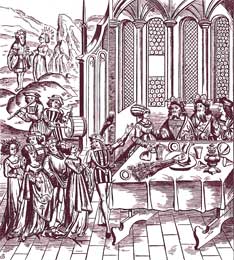 I’m back!
I’m back!
I wish I could just pour out all of the fascinating things I have to tell you — the first being a fun fact about the history of French cuisine.
I adore fun facts.
Especially when food is involved. In high school I spent much time sitting on the itchy, green carpet in the library stacks, devouring over and over a few books (I actually think they were for kids and young adults) from the 70’s on medieval and renaissance-era eating and cooking in Europe. One of them might be this one I found on Amazon, called “Fabulous Feasts: Medieval Cookery and Ceremony.” Not sure. But I’m probably going to order it and find out.
Medieval European aristocracy was seriously into the “wow” factor. Theatrical feasts on thick tables piled with plates of roasted pheasants, castles made of gilded chicken drumsticks and live birds flying out of pie crusts (where is my time machine?!). They used loads of spices to cover up the “ripeness” of their food. And loved dishes involving the stuffing of different meats, inside one another. And how about those huge turkey legs eaten by hand? Or is that just at the Ren-Faire?…
I could go on and on. BUT, here is my fun fact.
From what I read, the first professional french cookbook was written by a famous 14th century chef named Guillaume Tirel, whose nickname was “Taillevent” (trans. “Slicewind”). That’s right. Slicewind.
Taillevent (a former “kitchen boy” for Jeanne d’Evreux, Queen of France) worked his way up through a succession of french kings, one of whom, Charles V, commissioned Taillevent to codify his kitchen wisdom in a book titled “Le Viandier.” I just found what looks to be text from the original copy, now at the Vatican, and an English translation online.
If you didn’t know what a nerd I am yet, now you do.
January 28, 2008 at 7:25 pm
Nerd? Never!! Fun facts are the spice of life! All those people who think the chicken in the duck in the turkey is something new, never read books about Medieval and Renaissance feasting! Loved the image! I think those are glass rondels filling the window openings…
January 28, 2008 at 7:41 pm
As we see, the apple doesn’t fall far from the tree! Agreed totallement.
January 30, 2008 at 5:49 am
Betty–Connaissez-vous http://www.amazon.fr ?
On peut y trouver de nombreux livres dont il s’agit de l’histoire de la cuisine française et de l’histoire de la gastronomie. (Je le sais parce que j’en ai commandé plusiers pour notre bibliothèuqe quand notre collège a commencé à offrir des cours de la cuisine française enseignés entierment en français. : -)
Par exemple:
Main Author: Sabban, Françoise.
Title: La gastronomie à la Renaissance : 100 recettes de France et d’Italie /
Publication Information: [Paris] : Stock, c1997.
(Désolée pour la mauvaise grammaire. Je suis très fatiguée, et la tête ne marche pas. )
January 30, 2008 at 6:46 am
OOOH! this looks great! Thanks for the tip. Now I’m wanting to find a few good antique recipes to make as conversation pieces. I just found an Anne Willan cookbook, now maybe out of print, on recipes of the great chefs of Europe going back to Taillevent!